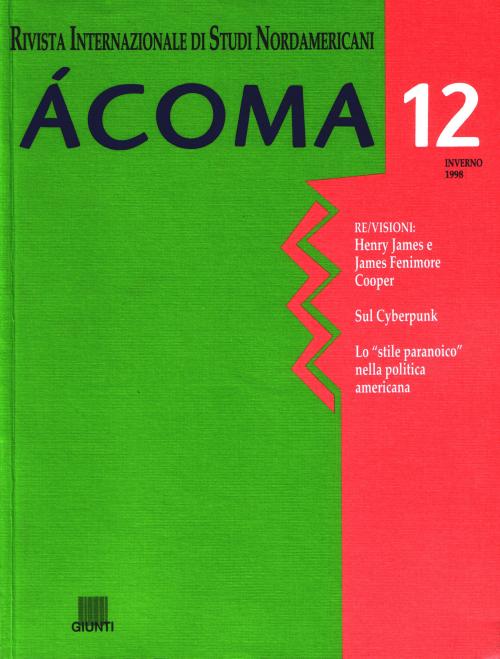Tu sei qui
RE/VISIONI
Numero 12
Inverno 98 - Anno V
 RE/VISIONI: Henry James e James Fenimore Cooper
RE/VISIONI: Henry James e James Fenimore Cooper
 Sul Cyberpunk
Sul Cyberpunk
 Lo "stile paranoico" nella politica americana
Lo "stile paranoico" nella politica americana
Testo a fronte
Amy Lowell – pag. 4
"The sisters" – pag. 6
Re/visioni
Cooper e l'ultimo dei mohicani – pag. 14
On the basis of recent developments in the critical appreciation of James Fenimore Cooper, and of his Leatherstocking cycle, the article analyses how Cooper’s approach to the history of his country and to his sources on frontier history influences the construction of The Last of the Mohicans. The study is especially focussed on two major issues: the relationship between the description of the Fort William Henry massacre and Cooper’s preoccupation with the American revolutionary war, and his treatment of eastern Indians’ civil and political life.
L’ultimo dei mohicani: il romanzo, il film e il problema dell'identità nazionale – pag. 27
A comparative reading of both Michael Mann’s movie The Last of the Mohicans and Cooper’s novel can help us shed new light on their respective ideological strategies. Even though ultimately both texts try to rationalize the dispossession of native America, Cooper does not hide the brutal and bloody side of the new nation’s Indian policy. Mann’s revisionism, on the other hand, offers a more ethnographically correct picture of Northeast American Indians; yet, in its effort to forge a nobler and gentler Natty Bumppo, the movie turns out to be a good deal more conciliatory than the book.
Nel segno di Isabel Archer – pag. 37
Henry James’s The Portrait of a Lady relies on what might be termed an Althusserian notion of ideology and its role in the construction of the subject. Isabel’s portrait emphasizes the clash between the liberal humanist discourse of autonomy and freedom of choice and the subject’s subjection to ideology, namely, patriarchal ideology. The novel textually foregrounds the workings of patriarchal ideology, thus bringing about a new awareness of its constitutive role and naturalizing function both in the reader and, arguably, in the protagonist. The essay also examines Jane Campion 1996 movie The Portrait of a Lady, a coherent feminist reading of the novel highlighting its marginal, eccentric, protofeminist features.
Freedom, Fortune, and Fancy. Henry James e la frontiera – pag. 52
Images of boundlessness, expansion, absolute freedom occur both in Henry James’s The Portrait of a Lady and The Wings of the Dove and Frederick Jackson Turner’s “The Significance of the Frontier in American Life”. Both share the belief that freedom is only such as long as it is entirely untrammelled, and the underlying sense that any action or choice of the free subject may result in a restriction of the unlimited possibilities. While the Jamesonian heroines’ freedom and imagination are postulated on boundless financial fortunes and absence of binding ties, other American texts (Rebecca Harding Davis, Frederick Douglass, Theodore Dreiser) suggest that imagination may be based less on the absence of limits than on the effort to overcome them. James’s link of freedom, imagination, and money appears thus to be closely related both to his time’s frontier ideology, and to more contemporary tenets of free-market liberal thought.
Aggiornamenti
Intorno al cyberpunk – pag. 63
Notions of the cyborg and of virtual space (the bodily and topological interface between human beings and machines) appear in American discourse throughout this century. The history of these metaphors is a continuing discourse between science fiction (including contemporary Cyberpunk) and various kinds of cultural theory - a history that places contemporary “cyberculture” in a consistent tradition of visionary speculation with powerful ideological agendas. This paper surveys this non-fiction (including most cyberpunk criticism), suggesting that novelists and theorists such as Gibson and Haraway should be regarded as oppositional figures.
Saggi
Da McCarthy a oggi: rilettura di The Paranoid Style in American Politics – pag. 77
Richard Hofstadter The Paranoid Style in American Politics described an attitude which is still present in today’s United States. While old fears are still in place, new ones emerge (Pow/Mia, the Kennedy Assassination etc.) as a consequence of the increasing political relevance of the religious right, but also of a growing sense of powerlessness and fragmentation generated by the media.
Populismo e antisemitismo nell'America della Depressione: il caso di Padre Coughlin – pag. 86
In the late 1930’s anti-Semitism reached sizable proportions in the United States also. Its main spokesman was Charles E. Coughlin, the hugely popular “radio priest” who in earlier years had formulated distinctly populistic programmes for economic reconstruction based on direct democracy, communitarianism and redistribution of wealth, and had grown increasingly critical of FDR’s policies. Most authors explain away Coughlin’s anti-Semitism as frustration, philonazism, and basic paranoia. He embodies two important traditions, both potentially conducive to anti-Semitism. One is Catholicism as represented, on the one hand, by the social activism promoted by Rerum Novarum, on the other hand by the evolution of religious anti-Semitism into a complex phenomenon adding economic and political arguments to older allegations of deicide and blood libel. The other tradition is populism, seen in this analysis as inclusive of those aspects of cultural and ethnic intolerance that post-Hofstadter historiography has denied or played down.

